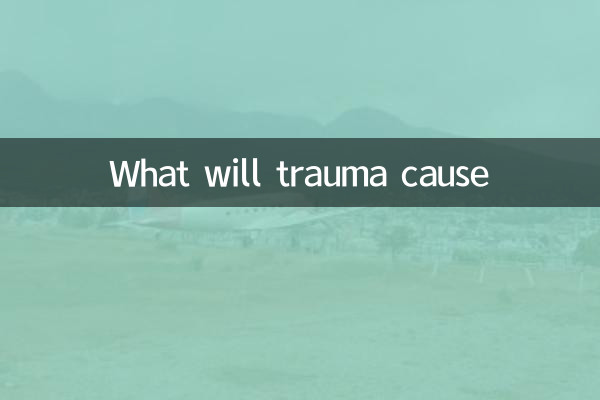What will trauma cause? ——Comprehensive analysis of common consequences and response measures of trauma
Trauma refers to tissue damage caused by external forces on the human body, which is commonly found in traffic accidents, sports injuries, falls or violent events. According to the popular topics and hot content on the entire network for the past 10 days, health problems caused by trauma have attracted much attention. This article will systematically analyze various possible consequences of trauma and provide structured data for readers' reference.
1. Common types and direct consequences of trauma

| Trauma type | Direct consequences | Highly occurring groups |
|---|---|---|
| Skin abrasions/lacerations | Bleeding, infection risk, scar formation | Children, athletes |
| fracture | Severe pain, dysfunction, deformity | Elderly, extreme sports enthusiasts |
| Head injury | Concussion, intracranial hemorrhage, disorders of consciousness | Traffic accident victims |
| Visceral damage | Internal bleeding, organ failure | A person who fell from a high altitude |
2. Secondary problems that may arise from trauma
In addition to direct tissue damage, trauma can also cause a range of secondary health problems that are often overlooked but are more harmful:
| Time phase | Secondary problems | Incidence rate |
|---|---|---|
| Acute period (within 24 hours) | Traumatic shock, infection, thrombosis | About 15-20% |
| Subacute phase (1-7 days) | Poor wound healing, stress response syndrome | About 10-15% |
| Chronic period (after 1 month) | Chronic pain, post-traumatic stress disorder (PTSD), dysfunction | About 5-10% |
3. Special risks of trauma in different parts
According to the latest medical research and clinical data, trauma in different parts of the body can bring specific health risks:
| Injured area | Special risks | Key warning symptoms |
|---|---|---|
| head | Cognitive dysfunction, delayed intracranial hemorrhage | Continuous headache, vomiting, and change of consciousness |
| Chest | Pneumothorax, heart contusion, rib fracture and internal organs | Difficulty in breathing and chest pain |
| abdomen | Late splenic rupture, intestinal perforation | Aggravated abdominal pain, abdominal distension, shock symptoms |
| spine | Permanent nerve injury and paralysis risk | Limb numbness, incontinence |
4. The psychological impact of trauma cannot be ignored
Recent social hot events show that the impact of trauma on mental health is becoming increasingly important. After major trauma, about 30% of patients will have different degrees of psychological problems:
| Psychological problems type | Main performance | High incidence time |
|---|---|---|
| Acute stress disorder | Nightmare, flashback, emotional numbness | Within 1 month after injury |
| Post-traumatic stress disorder (PTSD) | Continuous fear, avoidance of behavior, excessive alertness | 3-6 months after injury |
| depression | Continuous depression, loss of interest, suicidal thoughts | 2-12 months after injury |
5. How to prevent adverse consequences of trauma
According to the experts’ recommendations in recent hot health topics, the following points should be paid attention to to prevent adverse trauma:
1.Treat the wound correctly in a timely manner:Cleaning the wound, stop bleeding appropriately, and seeking medical treatment and sutures can reduce the risk of infection by 70%.
2.Pay attention to rehabilitation treatment:Data show that early standardized rehabilitation can reduce the incidence of dysfunction by about 40%.
3.Psychological intervention:Receiving psychological assessment and intervention within 1 month after injury can reduce the incidence of PTSD by more than 50%.
4.Regular follow-up:Especially for patients with head, chest and abdomen trauma, it is crucial to have a follow-up examination one week or one month after injury.
5.Reasonable nutrition support:A high-protein, vitamin C and zinc-rich diet can speed up wound healing.
Conclusion
The impact of trauma is far more than the wounds seen on the surface. From physical injuries to psychological trauma, from acute to chronic stages, we need to fully understand and respond scientifically. Through the structured data analysis in this article, I hope it can help everyone understand the various problems that trauma may cause and take the correct way to deal with them when encountering trauma. Remember, prevention is better than treatment, and safety protection in daily life is always the first priority.

check the details

check the details